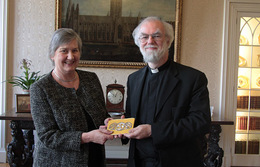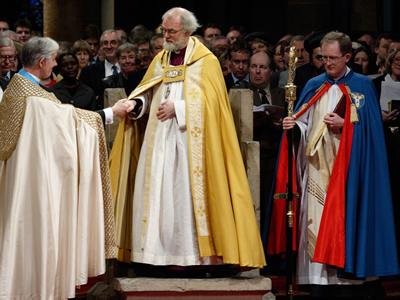Archbishop returns his robes to the Welsh people

Friday 23rd November 2012
The Archbishop has returned the robes given him by the people of Wales on his enthronement ten years ago.The robes were presented to Dr Williams in 2003 to celebrate his achievements and the pride of Wales at sending a religious leader onto the world stage for the first time in centuries.
 Dr Williams wore the robes for his enthronement at Canterbury Cathedral in February 2003, and throughout his 10 years as Archbishop.
Dr Williams wore the robes for his enthronement at Canterbury Cathedral in February 2003, and throughout his 10 years as Archbishop.
The exquisite garments remained property of the Welsh people, to be returned when the Archbishop’s term ended.
In a ceremony at Lambeth Palace, the Archbishop thanked the president of the National Museum Wales, where the robes will be housed, before handing them over. After the president signed a form, the robes became national property of Wales.
All items of the robes were designed and made in Wales, as far as possible using Welsh materials. They were paid for by an anonymous donation of £10,000.
 The cope, mitre and stole (the cloak, hat and symbol of priestly ministry worn by an Archbishop) are hand-woven in silk, embroidered with goldwire work and lined with Welsh flannel.
The cope, mitre and stole (the cloak, hat and symbol of priestly ministry worn by an Archbishop) are hand-woven in silk, embroidered with goldwire work and lined with Welsh flannel.
The silver and red gold morse – the clasp that holds the cope – is a design incorporating Welsh and English symbols united in friendship, and includes a component of Welsh gold.
The white robe worn beneath the cope and mitre, called the rochet, was made by the only weaver of fine linen in Wales.
In their new home at National Museum Wales, the robes will be a leading exhibit to demonstrate contemporary Welsh craftsmanship.
John Williams-Davies, the Director of Collections & Research at the museum said "Amgueddfa Cymru - National Museum Wales is delighted to accept the Archbishop's very generous gift of his enthronement robes in accordance with his wish that the robes should be returned to Wales upon his retirement. These magnificent vestments are a historic and significant addition to our collections and will take pride of place at the new National History Museum that we are developing at St Fagans"
He went on to say "It is particularly appropriate that these wonderful examples of the weaver's craft should come to St Fagans which has been a centre for the preservation and promotion of crafts skills from the outset. I am sure that they will serve as a source of inspiration for generations of craftsmen and women to come."
